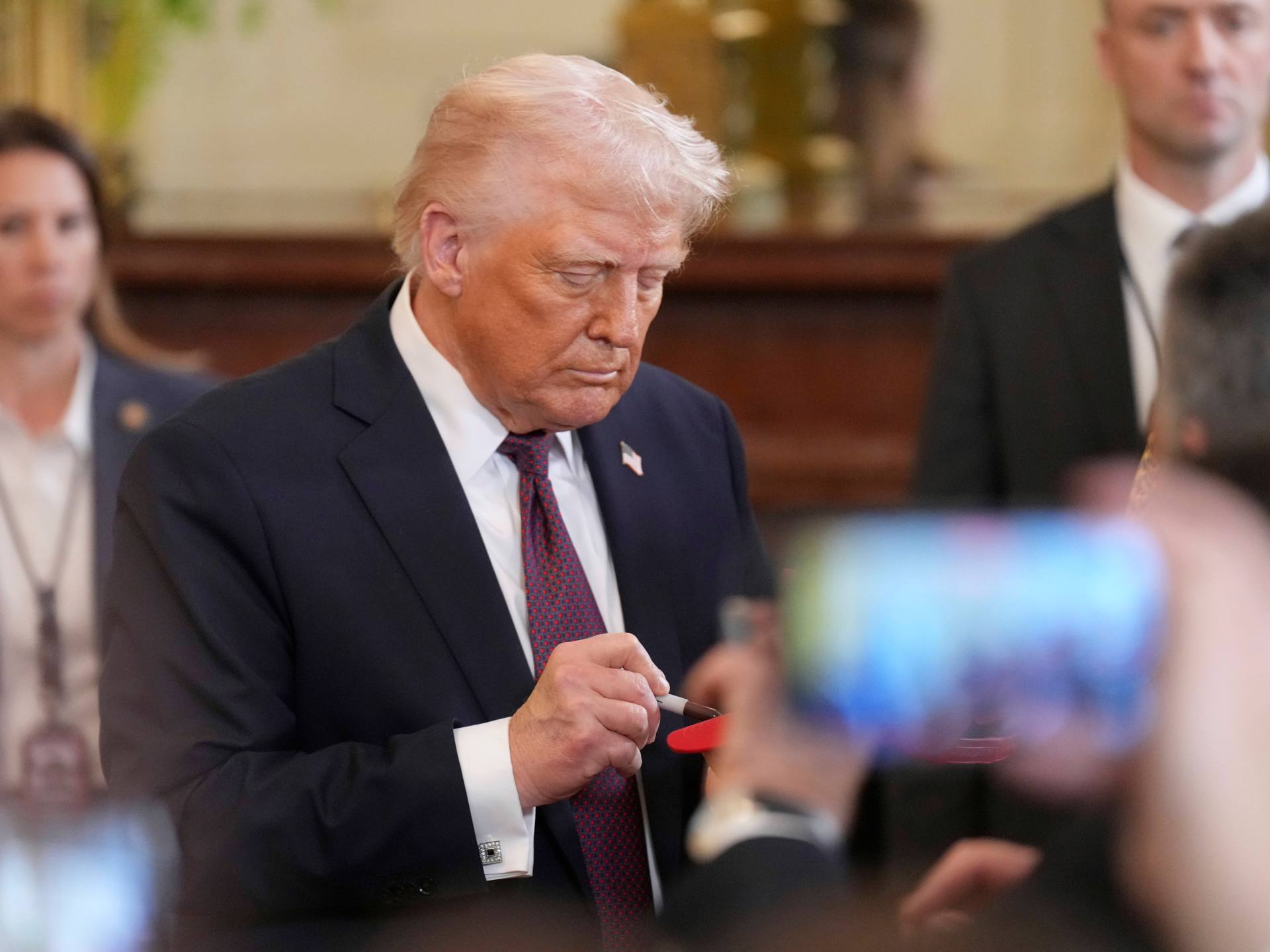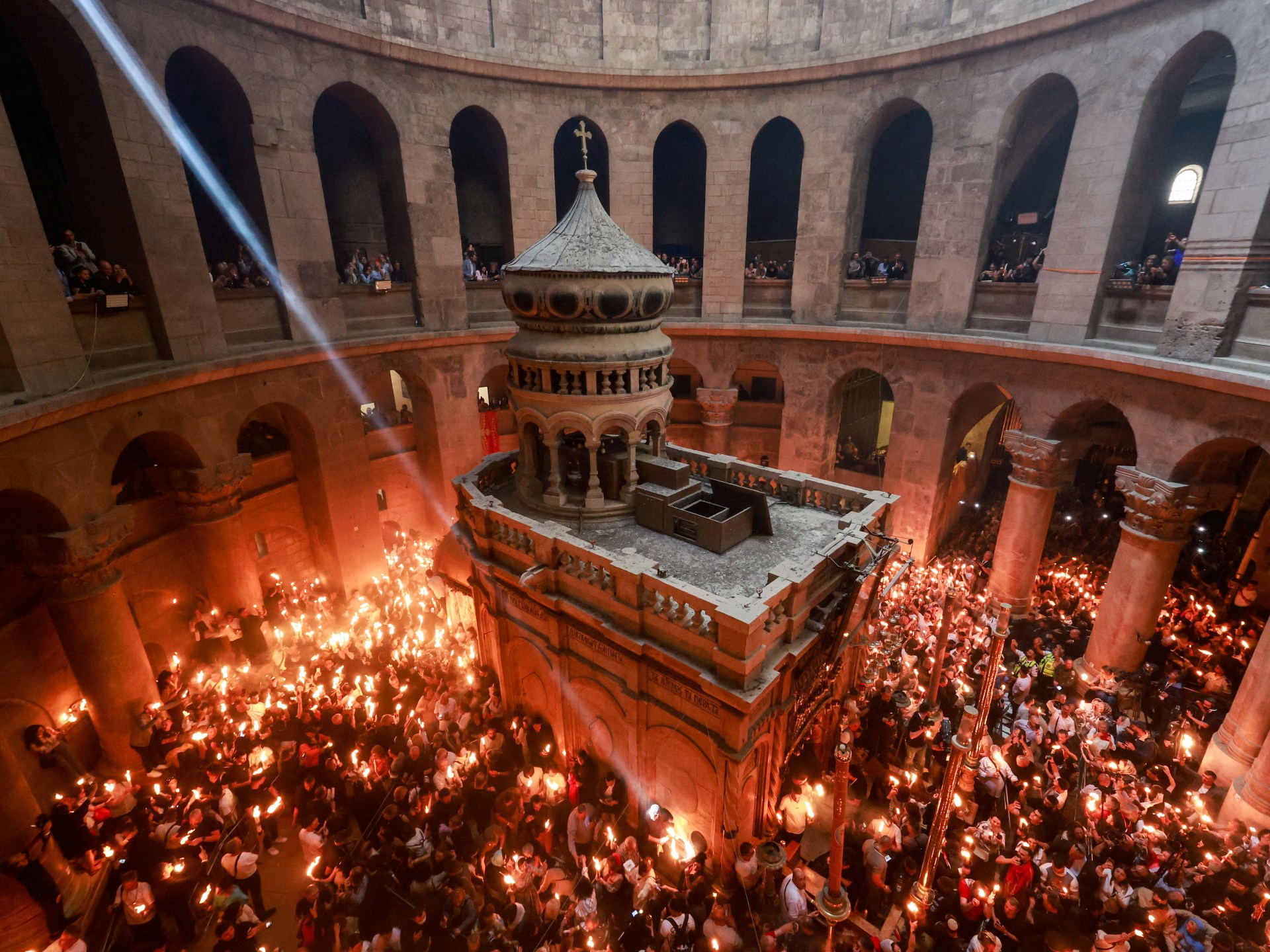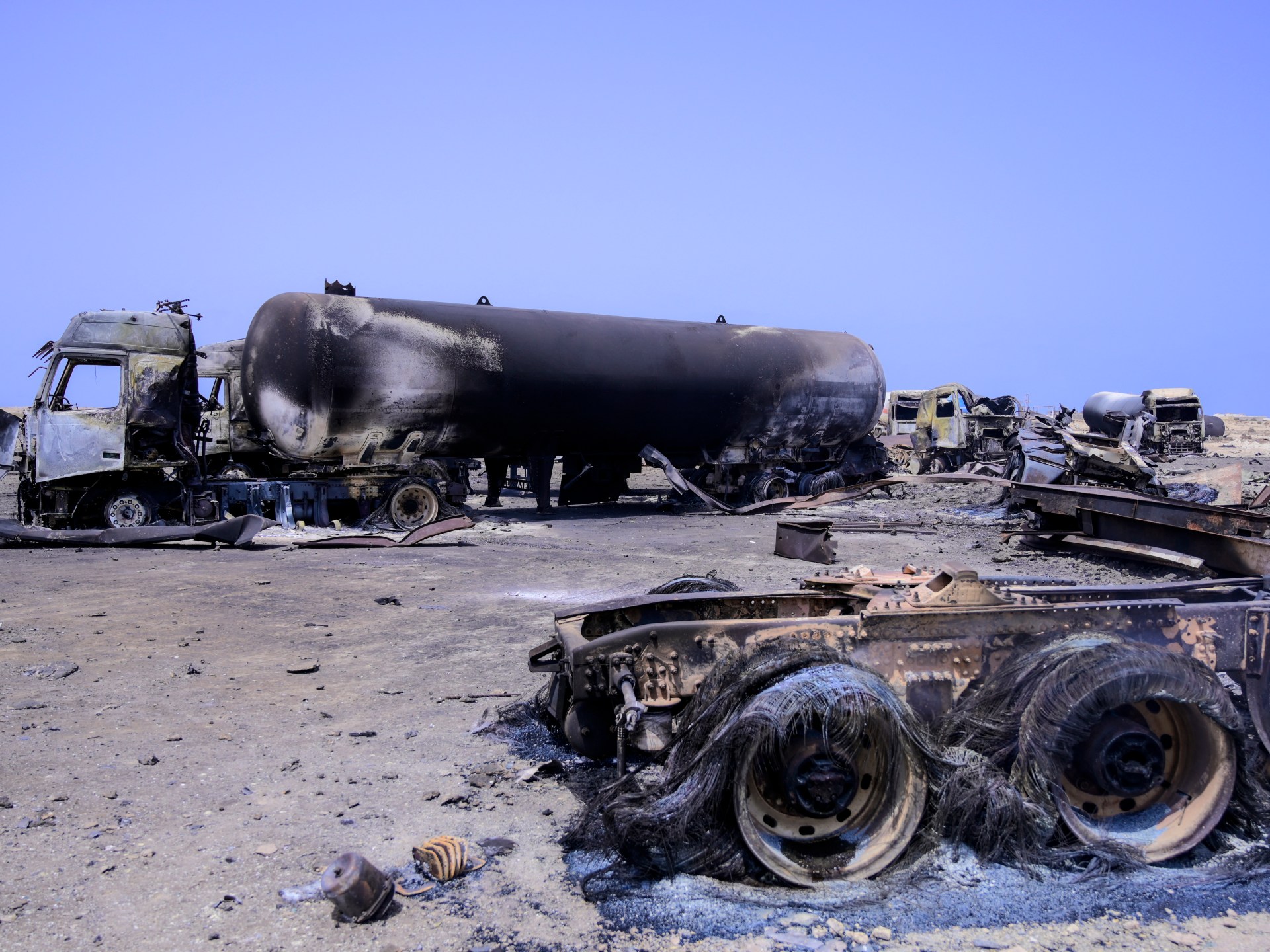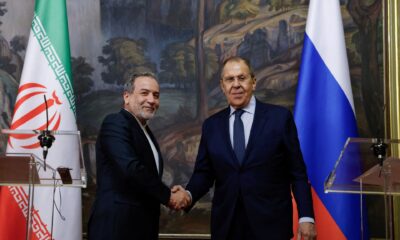Middle East
‘A shocking breach’: Trump officials leak Yemen attack plans in Signal chat | Donald Trump News

The administration of United States President Donald Trump has confirmed that a journalist from The Atlantic magazine was included in a private social media chat about upcoming attacks on the Houthi armed group in Yemen.
On Monday, The Atlantic published an article from editor-in-chief Jeffrey Goldberg, in which he described the stunning realisation that he had been added to a group chat where high-level government officials were discussing military actions.
“The world found out shortly before 2 p.m. eastern time [18:00 GMT] on March 15 that the United States was bombing Houthi targets across Yemen,” Goldberg wrote in the opening lines of his article.
“I, however, knew two hours before the first bombs exploded that the attack might be coming. The reason I knew this is that Pete Hegseth, the secretary of defense, had texted me the war plan at 11:44 a.m [15:44 GMT].”
Goldberg explained that he received a messaging request from a user named “Michael Waltz” on the encrypted messaging app Signal. At first, he doubted that this Waltz could be the real Michael Waltz, Trump’s national security adviser.
But soon, he found himself in the midst of a conversation with 18 government officials, some of whom appeared to be Secretary of State Marco Rubio, Vice President JD Vance and Hegseth.
“I have never seen a breach quite like this,” Goldberg wrote. He ultimately notified the White House about the security breach and removed himself from the chat.
The Trump administration has confirmed the incident in a statement from the National Security Council that was shared with the media.
“At this time, the message thread that was reported appears to be authentic, and we are reviewing how an inadvertent number was added to the chain,” council spokesperson Brian Hughes said in the statement.
“The thread is a demonstration of the deep and thoughtful policy coordination between senior officials.”
At a news conference later on Monday, State Department spokesperson Tammy Bruce declined to comment, referring reporters to the White House.
Trump was likewise pressed on the scandal during a White House event to unveil a steel mill for the automaker Hyundai in Louisiana.
“I don’t know anything about it,” Trump began, before taking a swipe at the magazine itself.
“I’m not a big fan of The Atlantic. To me, it’s a magazine that’s going out of business. I think it’s not much of a magazine, but I know nothing about it.”
He proceeded to ask reporters to give him details about the security breach.
“What were they talking about?” Trump asked. He then appeared to confuse the breach with an intentional attempt to subvert the US military operation in Yemen.
“It couldn’t have been very effective because the attack was very effective. I can tell you that,” Trump said. “I don’t know anything about it. You’re telling me about it for the first time.”
But critics are already calling for an investigation into what occurred. Senator Chris Coons, a Democrat from Delaware, was among those who said Congress should hold an oversight hearing and demand accountability.
“Jeffrey Goldberg’s reporting in The Atlantic calls for a prompt and thorough investigation,” Coons wrote on social media.
“If senior advisors to President Trump in fact used non-secure, non-government systems to discuss and convey detailed war plans, it’s a shocking breach of the standards for sharing classified information that could have put American servicemembers at risk.”

What happened?
The latest wave of US attacks against the Houthis came on March 15, after Trump announced on social media that he had ordered the military “to launch decisive and powerful” actions against the Yemeni group.
But Goldberg’s interactions with the private Signal chat offer a glimpse at how that decision came about.
The Houthis have long been the subject of US military action, including under Trump’s predecessor, Democrat Joe Biden.
Since October 2023, the Houthis have attacked Israeli vessels and commercial ships in the Red Sea and surrounding waterways, as a means of protesting against Israel’s war in Gaza.
Approximately 100 merchant ships have come under Houthi fire from that point onwards, and two have been sunk. However, the Houthi attacks came to a halt in January, when a short-lived ceasefire took hold in Gaza.
Still, Trump announced early in his second term that he would designate the Houthis a “foreign terrorist organisation”, an action that was fulfilled earlier this month.
Then, on March 2, Israel began to block humanitarian aid from reaching Gaza, which lacks adequate food and medical supplies. In response, the Houthis warned they would attack if the blockade was not ended. The ceasefire in Gaza has since disintegrated, leading to further death and destruction in the Palestinian territory.
It was March 11 when Goldberg said he received his invitation from Waltz, the national security adviser, on Signal.
“It immediately crossed my mind that someone could be masquerading as Waltz in order to somehow entrap me,” Goldberg wrote in The Atlantic.
“I accepted the connection request, hoping that this was the actual national security adviser, and that he wanted to chat about Ukraine, or Iran, or some other important matter.”
Two days later, Goldberg instead found himself part of a private chat entitled, “Houthi PC small group”. There, some of the most senior officials in the US government appeared to be discussing an imminent attack on Houthi strongholds in Yemen, including the capital Sanaa.
“I had very strong doubts that this text group was real,” Goldberg explained. “I also could not believe that the national security adviser to the president would be so reckless as to include the editor in chief of The Atlantic in such discussions with senior U.S. officials, up to and including the vice president.”
The access, however, granted Goldberg a front-row seat to some of the back-room haggling unfolding in the Trump administration – and some of the policy schisms those discussions reveal.
A participant in the chat who appeared to be Vice President Vance expressed concern that attacking the Houthis would ultimately benefit European trade more than US shipping interests.
He proposed delaying the bombing campaign, in order to better gauge public opinion and the economic ramifications.
“I am willing to support the consensus of the team and keep these concerns to myself,” Vance said. “But there is a strong argument for delaying this a month, doing the messaging work on why this matters, seeing where the economy is, etc.”
A person identified as Defense Secretary Pete Hegseth responded that a delay would “not fundamentally change the calculus”. Nevertheless, he warned against the US dragging its feet.
“Immediate risks on waiting: 1) this leaks, and we look indecisive; 2) Israel takes an action first – or Gaza cease fire falls apart – and we don’t get to start this on our own terms,” Hegseth wrote.

Vance appeared resigned, his concerns most focused on the benefits any strikes might have for Europe.
“If you think we should do it let’s go. I just hate bailing Europe out again,” Vance replied.
Hegseth again chimed in, “VP: I fully share your loathing of European free-loading. It’s PATHETIC. But Mike is correct, we are the only ones on the planet (on our side of the ledger) who can do this.”
Another official, identified as SM, appeared to chime in on behalf of the president. Goldberg said he assumed this to be Stephen Miller, Trump’s homeland security adviser.
“The president was clear: green light, but we soon make clear to Egypt and Europe what we expect in return,” SM wrote.
“If the US successfully restores freedom of navigation at great cost there needs to be some further economic gain extracted in return.”
Goldberg declined to provide the operational details of the military strike that unfolded afterwards. But he did explain that the actions outlined in the group chat matched the bombs raining down in Yemen.
He also shared the jubilation that followed the military strikes: officials sharing emojis of the US flag, a flame and a flexing bicep.
“The Signal chat group, I concluded, was almost certainly real. Having come to this realization, one that seemed nearly impossible only hours before, I removed myself from the Signal group,” Goldberg wrote.
He questioned the legality of US officials discussing such sensitive military action on a social media platform.
“It is not uncommon for national-security officials to communicate on Signal. But the app is used primarily for meeting planning and other logistical matters – not for detailed and highly confidential discussions of a pending military action,” Goldberg explained.
“Had they lost their phones, or had they been stolen, the potential risk to national security would have been severe.”
The editor also questioned whether the officials on the chat were violating public records law. The messages in the chat were set to automatically delete after a certain period of time.
“Text messages about official acts are considered records that should be preserved,” Goldberg wrote.
Waltz himself could be in legal jeopardy for reportedly including Goldberg in the first place – thereby leaking national security information into the public sphere.
“The group was transmitting information to someone not authorized to receive it,” Goldberg said. “That is the classic definition of a leak.”
Middle East
The Hawaii of Israel: How Trump legitimised a longstanding Israeli vision | Israel-Palestine conflict

On April 7, United States President Donald Trump met Israeli Prime Minister Benjamin Netanyahu for a second time since his inauguration. Speaking to the media, Trump doubled down on his earlier comments about the Gaza Strip, describing it as an “incredible piece of important real estate”.
Trump also repeated his suggestion that the Palestinians should leave the Strip “to different countries” and claimed that people “really do love that vision. … A lot of people like my concept.”
Days later, about 70 percent of Gaza had been turned into a “no-go zone” for Palestinians. Confirming that Israel is working “in accordance with the US president’s vision, which we seek to realise”, Israeli Defence Minister Israel Katz declared Israel’s intention to “seize” more territory, adding that “wilful passage” will be given to Palestinians who want to leave.
It is by now clear that Trump’s statements on Gaza have had the effect of legitimising a longstanding Israeli vision of ethnic cleansing of the Strip. What the US president calls “my concept” is in fact not his at all.
Over decades of Israeli occupation and colonisation of the Gaza Strip, there have been multiple plans to empty out or disperse the Palestinian population in a bid to secure full control over this part of Palestine. The power of colonial practices has also been tested. For example, to draw Israeli settlers and thereby help transform Gaza’s demographics, the Strip was at one point even promoted as the “Hawaii of Israel”.
Left out of Israeli war aims in the 1948 Arab-Israeli War, the Gaza Strip emerged out of the 1949 Armistice Agreements under Egyptian military rule. Constituting only a small part of what until then had been the Gaza District of Palestine, the Gaza Strip was home to two groups of Palestinians: the local population and refugees – people who had been forced off their land as Israel expanded its territorial reach during the war.
As the guns fell silent, the Gaza Strip became known in Israeli policy circles as the “job unfinished” – a slice of land next to the Egyptian border that Israel’s leaders would like to control, preferably without its Palestinian population.
Israel’s first attempt to take Gaza by force occurred in 1956. But under pressure from US President Dwight Eisenhower, Israeli Prime Minister David Ben-Gurion had no choice but to withdraw and put an end to the Israeli occupation. The botched attempt taught Israel an important lesson: To redraw the map of the Middle East and to make its territorial expansionist agenda a success, Israel needed American support and approval.
The 1967 Arab-Israeli War was far more successful in this regard. Through conquest and occupation, the Gaza Strip was brought under direct Israeli rule. This opened the door to revitalise “transfer” – the forced displacement and ethnic cleansing of Palestinians. Seen as both necessary and permissible or, in Ben-Gurion’s words, “an important humane and Zionist idea”, transfer was recognised as an effective tool to advance Zionist colonisation of Palestine.
In the following years, as noted by Palestinian historian Nur Masalha, transfer acquired different labels. These included “population exchange”, “Arab return to Arabia”, “voluntary emigration” and “rehabilitation” with different Israeli governments taking different approaches.
One approach was Defence Minister Moshe Dayan’s “open bridges”, which allowed Palestinians in Gaza to leave for other countries in search of work. Another was to open offices in Gaza’s refugee camps to organise and pay for travel and passports for Palestinians willing to “voluntarily migrate”, which in effect turned the Israeli Ministry of Foreign Affairs into a “global travel agency”. Regardless of the approach, Israel’s policy objective remained the same: to create a drive in Palestinians to leave the Strip.
“I want them all to go, even if they go to the moon,” Israeli Prime Minister Levi Eshkol said. Expressing Israeli frustration, Eshkol articulated the feeling of being stuck with what was considered the problem of Gaza. After all, only the Palestinian population there – and the sizeable refugee population in particular – stood in the way of full Israeli annexation.
In response to Israel’s Gaza “dilemma”, its politicians also looked for more comprehensive solutions. This led to an almost continuous flow of plans for the “rehabilitation” of Palestinians outside the Strip. Starting immediately after the 1967 war, a variety of potential destinations came up. These included the West Bank, the Sinai Peninsula, Iraq, or even as far afield as Canada and Australia.
Despite Israeli efforts and elaboration of plans – and much to the disappointment of Israel’s decision-makers – the initiatives came to naught as the number of Palestinians leaving the Strip remained limited. And given other considerations, including moral, legal and diplomatic ones, the plans to displace a large number of Palestinians from Gaza were left in the drawer.
But as Israeli politicians turned to examine their menu of choices in the post-October 7, 2023, era, “voluntary emigration”, or forced displacement, re-emerged. Gone was any sensitivity to international opinion and potential reactions. Instead, Trump has led the way, making statements on Gaza that in effect turn decades of Zionist ideology and practice into official American policy.
By means of his policy stance, the US president has legitimised a longstanding Israeli vision of ethnic cleansing in the Strip. In the process, his articulation of policy has moved ever closer to the strand of Revisionist Zionism that viewed Palestinians as aliens in their own land and, therefore, “transferable”.
In arguing that Palestinians need to go to make Israel and the region safe, Trump has departed from the internationally shared principle that Palestinians in the Gaza Strip – as elsewhere in the occupied Palestinian territory – have legitimate rights to self-determination in their land. As such, Trump brings to mind Revisionist Zionist ideologue Ze’ev Jabotinsky, who argued that “when the Arab claim is confronted with our Jewish demand to be saved, it is like the claims of appetite vs the claims of starvation” with “transfer” inextricably linked to Jewish rights to the land.
The cynical promises of a better future for people who are left with nothing but their land after a brutal war of erasure and plausible genocide must be taken seriously. The legitimacy Trump has given to Israeli plans poses a threat in the here and now, but it could also outlast his presidency.
That is because he has offered US presidential sanction of ethnic cleansing as an acceptable tool. This leaves the door open for Israel – in the near or distant future – to pursue “transfer”, “rehabilitation” and “voluntary emigration” of Palestinians, whether in Gaza or the West Bank.
Furthermore, the American president has repeatedly communicated US support for illegal land seizures and colonisation. Suggesting Gaza (and Greenland) could become “US territory”, he has reintroduced and validated ideas that most leaders of the world had put on the scrap heap of history.
Finally, Trump has shifted the US position away from the premise of working towards a two-state solution. In fact, considering his statements, there appears to be a fundamental disregard for Palestinians in Gaza and their collective right to self-determination.
Looking at current US policy against historical record, Trump’s “Riviera of the Middle East” seems a curious combination of Zionist ethnic cleansing under the “transfer” model and the colonial ideal of the “Hawaii of Israel”.
It is no wonder Trump has been cheered on by Israeli leaders as he calls for the forced depopulation of the Gaza Strip and its transformation into fully fledged colonial territory – annexed or otherwise. After all, Trump’s ideas follow in the footsteps of Zionist leaders from Ben-Gurion to Netanyahu, under whom transfer has been the preferred but diplomatically and legally challenging option all along.
With Trump going out in front, such challenges could turn into tomorrow’s opportunities. It remains the task of other states to stand up against Israeli-American normalisation of continued ethnic cleansing and colonial land grabs in Palestine.
The views expressed in this article are the author’s own and do not necessarily reflect Al Jazeera’s editorial stance.
Middle East
Thousands gather for centuries-old Holy Fire ceremony in Jerusalem | Jerusalem News

Thousands of Christians gathered in the cavernous Church of the Holy Sepulchre for a centuries-old Holy Fire ceremony.
Holding unlit candles, they packed into the sprawling 12th-century basilica built on the site where, according to tradition, Jesus was crucified and buried.
In near-total darkness, the Greek patriarch entered the Holy Edicule and emerged with two lit candles. The flame was passed from one candle to the next, the light overcoming the darkness in the rotunda. The flame was later transferred to Orthodox communities in other countries on special flights.
Eastern Orthodox Christians believe the light miraculously appears inside the Holy Edicule, built on the traditional site of Jesus’s tomb, while sceptics going back to the Middle Ages have dismissed it as a carnival trick for the masses.
Either way, the ceremony, which goes back at least 1,200 years, is a sight to behold. It has also ignited safety concerns.
In 1834, a frenzied stampede broke out in the darkened church, and the ruler of the Holy Land at the time barely escaped after his guards drew swords and hacked their way through the crowd, historian Simon Sebag Montefiore recounts in his history of Jerusalem. Some 400 pilgrims died in the melee, most from suffocation or trampling.
Israeli authorities have sought to limit participants in recent years, citing safety concerns. That has drawn protests from church leaders, who have accused them of upsetting the delicate, unwritten arrangements around Jerusalem’s holy sites known as the status quo.
On Saturday, there was a heavy military presence as thousands of worshippers passed through Israeli checkpoints to enter.
Some worshippers lamented that the turnout lacked numbers this year because of Israel’s 18-month war on Gaza. “The number of police is higher than the number of pilgrims,” said Adeeb Joude, key holder for the Holy Sepulchre.
Israel captured East Jerusalem, including the Old City with major sites sacred to Jews, Christians and Muslims, in the 1967 Middle East War, and annexed it in a move not recognised internationally. The Palestinians want East Jerusalem to be the capital of their future state.
The Old City has a long history of tensions between Israelis and Palestinians, among different religious groups that share its hilly confines and even within certain faiths. Perceived infringements on the status quo in the Church of the Holy Sepulchre have led to brawls between monks of different denominations.
Israel says it is committed to ensuring freedom of worship for Jews, Christians and Muslims, and has long presented itself as an island of tolerance in the Middle East.
In recent years, however, tensions have risen with the local Christian community, most of whom are Palestinian Christians, a population that has dwindled through decades of conflict as many have moved abroad.
Middle East
US attacks Yemen again after at least 80 people killed in Hodeidah | Israel-Palestine conflict News

UN chief Antonio Guterres says he is ‘gravely concerned’ about US air strikes this week on Yemen.
The United States has carried out 13 air strikes on Hodeidah’s port and airport, the Houthi-affiliated TV channel Al Masirah says, two days after a US air strike targeted the Ras Isa port, also in Hodeidah, killing at least 80 people and wounding more than 150.
Al Masirah also reported Saturday that three people were killed and four injured due to a US attack on al-Thawra, Bani Matar, and al-Safiah districts in the capital Sanaa.
The Houthis have promised to carry out “more operations” despite the ongoing US attacks.
US President Donald Trump’s administration announced a major military offensive against the Houthis a few weeks ago. It said the air strikes are aimed at forcing the Houthis to stop threatening ships sailing on the Red Sea on a route crucial to international trade.
Since November 2023, the group has reportedly launched more than 100 attacks on vessels it says are linked to Israel in response to Israel’s war on Gaza and in solidarity with Palestinians.
On Friday, Houthi official Mohammed Nasser al-Atifi told Al Masirah that the “American enemy’s crimes” will not deter the Yemeni people from supporting Gaza, but “rather will strengthen their steadfastness and resilience”.
The Houthis, also known as Ansar Allah or “supporters of God”, are an armed group that controls most parts of Yemen, including Sanaa. The group emerged in the 1990s but rose to prominence in 2014 when it seized Sanaa and forced President Abd-Rabbu Mansour Hadi to flee the country.
United Nations Secretary-General Antonio Guterres “is gravely concerned about the airstrikes conducted by the United States over the course of 17 and 18 April in and around Yemen’s port of Ra’s Isa, which reportedly resulted in scores of civilian casualties, including five humanitarian workers injured,” Guterres spokesman Stephane Dujarric said in a statement on Saturday.
Guterres expressed fears of damage to the port and “possible oil leaks into the Red Sea”, Dujarric added.
The strikes on Ras Isa aimed to cut off supplies and funds for the Houthis, the US military said. It was the deadliest attack of Washington’s 15-month campaign against the Iran-aligned group.
About 70 percent of Yemen’s imports and 80 percent of its humanitarian assistance pass through the ports of Ras Isa, Hodeidah and as-Salif.
Ras Isa also is the terminus of Yemen’s main oil pipeline, which, along with its port, are “critical and irreplaceable infrastructure” in Yemen, according to the UN Development Programme.
-

 Education2 days ago
Education2 days agoHarvard’s battle with the Trump administration is creating a thorny financial situation
-

 Europe2 days ago
Europe2 days agoTrump’s ‘lone ranger’: How Steve Witkoff became the defacto point man on America’s foreign policy challenges
-

 Conflict Zones2 days ago
Conflict Zones2 days agoIran has ‘doubts’ about US intentions ahead of nuclear talks | Politics News
-

 Europe2 days ago
Europe2 days agoThe Trump administration says Europe is taking advantage of the US. That’s not exactly true
-

 Conflict Zones2 days ago
Conflict Zones2 days ago‘How do I live like this?’ asks Gaza boy who lost arms in Israeli attack | Gaza News
-

 Conflict Zones2 days ago
Conflict Zones2 days agoTrump says US may ‘pass’ on helping end war if Russia, Ukraine resist deal | Russia-Ukraine war News
-

 Middle East1 day ago
Middle East1 day agoTunisian court hands opposition figures lengthy jail terms | Human Rights News
-

 Europe2 days ago
Europe2 days agoHow the US threat to ‘move on’ from peacemaking efforts in Ukraine could play out




